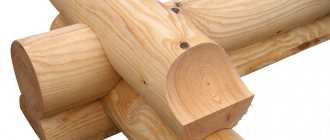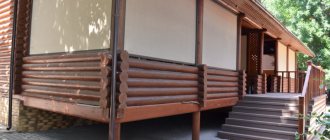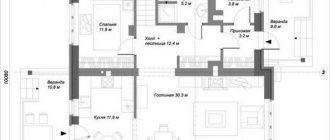The construction of any building begins with excavation work and foundation construction. The result of the construction of the facility and the reliability of its operation will depend on the chosen design solution, material, and method of installation of the base. At the same time, the cost of the building element and environmental safety are taken into account. Satisfying the listed requirements is possible during the construction of the TISE foundation. This type belongs to the group of pile or pile-grillage foundations.
TISE piles
The main disadvantage of the classic pile foundation is that with severe heaving, the support can simply be pushed out. But since the idea itself is very attractive - it can be built quickly with a minimum of costs - on difficult soils they began to make a base at the bottom of the pile - a rectangular reinforced plate. But with this option, the volume of land work immediately increased significantly: for each pile it is necessary to dig a pit larger than the planned base. But the building stands normally even on soils with severe frost heaving.
The pile foundation using TISE technology has a dome-shaped thickening at the base of each support
Under piles made using TISE technology create a similar thickening. But there is no need to dig pits. This extension is formed using a special knife, which is attached to a proprietary drill. This knife forms the extended dome. Further, the entire technology almost exactly repeats the process of constructing a pile or pile-grillage foundation.
Previously, expansions were also practiced, but they tried to do them using micro-explosions or by picking with a blade on a long pole. The main innovation in TISE technology is a drill with an opening adjustable blade. With its help, it is much easier to expand the sole.
How to work with a TISE drill
Advantages and disadvantages
TISE foundations are quickly gaining popularity: with minimal additional costs, a more reliable foundation is obtained. So, its advantages:
- increased resistance to heaving forces;
- the load from the house is transferred to a larger area, which reduces the possibility of uneven subsidence;
- low cost with good characteristics;
- can be designed for houses made of different materials, up to 3 floors in height;
- small amount of land work.
The procedure for making a TISE pile
If a pile or pile-grillage foundation is recommended for your house, it makes sense to make TISE piles. With a small increase in workload, you get a significant increase in reliability. After all, designers do not like pile foundations because it is impossible to find out what kind of soil is under each support. Therefore, it is impossible to predict how reliable and stable the foundation will be. And the TISE foundation has a wider support, which reduces risks. As before, nothing can be predicted, but a large load distribution area is always good.
However, there are also disadvantages. The main thing: the heel of a TISE pile cannot be well reinforced. You can lower the reinforcement cage to the very bottom, but expansion cannot be reinforced. Therefore, there remains the possibility that this thickening will collapse.
TISE piles are the basis of the TISE pile-grillage foundation
There is one more drawback, but this is from the practice of using a drill: it is not easy for them to work. The design itself is interesting. This is not a blade wrapped around a rod, but some kind of container with a composite bottom. Four blades set at an angle are welded on the plates that form the bottom. When you spin the drill, they loosen the soil. Since the bottom is not solid, the soil gets into the body, from where it needs to be removed.
The order of work is as follows: rotate the drill several times around its axis, take it out, and shake out the soil. They lowered it into the hole again, turned it several times, etc. The technology is not complicated, but the work is tedious. The device itself weighs 7-9 kg, plus soil. It needs to be raised and lowered frequently. Overall, it's tiring. Plus, no mechanisms are needed. The downside is that the work is not easy physically. Especially if the soil is rocky or dense clay.
Manufacturing of tape circuit
When pouring the grillage, remember that it must be a strong concrete structure, reliably reinforced around the perimeter
Pay attention to the quality of the mixture and the reliability of the reinforcement connections. Sequence of events:
- install and level wooden panels;
- cover the inner surface with plastic wrap;
- install reinforcement cages, connecting them with wire into a rigid contour;
- fix the immobility of the formwork using steel pins and transversely located bars;
- fill the prepared circuit with concrete mortar, remove air from the mass;
- Allow the concrete mixture to harden for 4 weeks.
Where can I use it?
There are no restrictions on the types and materials of buildings: you can make a TISE foundation for wooden, frame, brick and block buildings. Number of storeys - up to three.
The restrictions on soils are the same as when using pile foundations: it is necessary that the piles transfer the load to the soil with normal bearing capacity. To decide whether it is possible or not to use TISE, a geological study of the site in the place where construction is planned is necessary.
What does a TISE pile consist of?
Since the base of the pile is expanded and the resistance to buoyancy forces is greater, this technology can be used on heaving soils. But at the same time you need to consider: there is no point in placing piles closer than 1.5 meters. If placed closer, one extension of the sole will overlap the other. On the other hand, you can’t make a pile larger than 30 cm in diameter either - there is no such drill. If the load-bearing area with such parameters is not enough, you need to use a different type of foundation.
Construction
A universal foundation built using TISE technology is in demand, because it is inexpensive, and its construction does not take much time, and besides, everything can be done with your own hands. Initially, carefully prepare the site, namely, remove the top layer of soil and install cast-offs.
Then mark the location of the piles and the site. A hydraulic level is used for this. Then cut down the pegs a little and place nails on the outer corners of the area, fixing a rope on them, you can also use a strong fishing line. When this job is done, install stakes for the load-bearing walls.
To install the frame of the cast-off, round timber from a board 50 mm thick is used. It is recommended to use a garden auger. It is more economical and convenient to make a semi-solid cast-off, on which the zero level must be determined.
Then the installation of smooth bars is carried out, which are attached to the boards. There should be a zero level on top
Please note that the cast-off is installed for control, then it is dismantled. Dig a hole around the area and start drilling
To begin with, it is recommended to make approximately 5 wells, after which they need to be expanded.
If there is a small amount of sand in the soil, then drilling will be difficult and this work will take a lot of time. To make the process easier, pour 5 buckets of water into each well overnight, this will soften the soil and it will be easier to expand the well the next day. This way you can do it without special equipment.
When installing the TISE base, do not forget about the reinforcement. You can find out the length of the rod based on the depth of the support. If the reinforcement is barely noticeable from behind the column, it can later be used as a vibratory compactor for concreting, which will remove remaining air from the concrete.
The next procedure is waterproofing, for which roofing felt is used. For installation, the material must be divided into pieces and twisted into a cylinder. The product is placed in the well, but only when the fittings are installed. The visible end of the shirt is sprinkled with soil. Installation of the TISE foundation requires concreting as quickly as possible.
Once you have poured the pillars and backfilled the supports, begin making the grillage. To do this, shields are installed and covered with durable polyethylene. The formwork is secured with pins, and holes are made in the timber on both sides. One end of the stud is bent behind the other, on which a washer and nut are fixed. Reinforcement is installed on the studs and secured with plastic ties.
The undeniable advantage of this foundation is the lack of drainage. There is no need to insulate the blind area and fence. And so that the drains do not have a destructive effect on the areas adjacent to the blind area, storm gutters are installed outside.
Reviews of the branded drill
The main questions for developers are related to how realistic it is to drill wells manually using a proprietary drill. Looking at the video, it seems that this task is not easy. But here are some reviews.
The soil on my site is different: some are loam, some are dense clay, and such that you can only chop them with an axe. At first I thought about renting a motor drill, but I decided to try it straight away with a drill. And nothing, not very hard. As a result, I decided that a motor drill would not speed up the process much, so I made all 40 pieces by hand. During the day, 5-6 2-meter wells were produced. They drilled easily, but with expansion it was difficult: I already had dense soil there, and it was difficult to turn with the blade open.
Oleg, Kharkov
I modified the TISE drill I bought: I welded additional teeth, instead of a rope that opens the blade, I adapted a rod - now you can put pressure on it, and not just pull. And most importantly, I lengthened the handle so that two people could turn it. While they were drilling the extensions, they twisted it 90°, but the work became much easier. In general, I'm pleased.
Nikolay, Krasnoyarsk
Expansion and reinforcement
It is estimated that on average, three extensions per day can be easily done, but the filling itself is very time-consuming. So, for example, with a well diameter of up to 30 cm, the expansion will be up to 60 cm. In this case, about 30 kg of cement will be used per column
But it is important to ensure that the solution is not liquid.
It is recommended to take into account that if there is little sand in the soil, then water can effectively help. So, if you pour about 5 buckets of water into the finished wells overnight, expansions will be made much easier.
The next step is reinforcement. The length of the reinforcement should be equal to the length of the pillar itself plus 15 cm to form an air gap for the grillage and bend the lower and upper parts. So, if the length is about 1.5 m, then approximately 2 rods will be needed per post.
Having completed the reinforcement completely, it is worth taking care of high-quality waterproofing to increase service life, especially if the groundwater level is quite close to the surface. Typically, roofing felt is used for waterproofing.
The drill can be purchased at the store, or you can weld it yourself
The order of operations is as follows:
- cut the roofing material into pieces, you can directly on the ground;
- roll it up;
- fasten with paper clips and insert into the hole.
It is better to place it in the recess after the expansion is completely filled and all the fittings are installed. The protruding ends of such shirts can simply be sprinkled with soil previously removed from the recess and compacted.
Calculation of the TISE foundation
The calculation method is no different from the calculation in the general case. The load from the house is calculated and then compared with the total load-bearing capacity of the planned number and diameter of piles.
First, place the piles on the house plan. They must be in the corners and at the junctions of the walls. If the distance between the piles is more than 3 meters, intermediate ones are placed between them. So you place all the supports on the plan, adhering to the rule:
- minimum distance - 1.5 meters;
- maximum 3 m.
Then calculate the load from the house. To do this, you first need to calculate the weight of the house (all building materials + furniture, plumbing, heavy household appliances).
Average loads from different types of house components
Speaking on average, for buildings made of brick or shell rock, 2400 kg can be taken for each square of area, for light building blocks (foam concrete, aerated concrete, etc.) - 2000 kg, for wood and frames - 1800 kg. These average standards can be used as a preliminary guide. If you decide to take everything seriously, you will need to follow the entire methodology: counting materials of walls, ceilings, roofing, finishing, etc. Since the technologies and materials used may be different, the discrepancies can also be significant.
We multiply the resulting value by a correction factor - 1.3 or 1.4. This is a safety margin. The resulting figure is the load that will need to be transferred through the piles.
Now, using the table, you select what diameter the pile should have so that it can transfer the required weight.
Load-bearing capacity of piles of different diameters in different soils
If the planned number of columns with an expansion of the selected diameter can transfer the required load, you do not need to redo anything. If the transferred mass is too small, it is necessary to either increase the number of piles or make a “heel” of a larger diameter.
Erecting cast-offs
Marking the foundation for Tise piles is perhaps the most difficult and important stage. For these purposes, you can use a hydraulic level or, in extreme cases, a hose with water.
Recommended instructions for marking:
- determine the zero level. It should be at a distance of 35-45 cm from the ground;
- after determining the zero level, it is necessary to file the pegs and place them at the outer corners of the nails, pulling the ropes;
- distribute axial pegs for internal load-bearing walls;
- install cast-off frame. To do this, it is better to use wooden panels whose thickness is 50 mm and a garden drill. It is better if the cast-off is semi-solid - this is both practical and economical;
- secure the formwork with thick boards;
- nail smooth bars. Their upper part will form the zero level;
- on the bars, mark the location of the cord for the internal and external walls and the central axis for the pillars;
- drive in nails and tighten cords.
This stage is very important, because The overall stability of the building will depend on it.
TISE foundation: work order
The TISE technique itself has some recommendations:
- The piles should be buried approximately 20 cm below the freezing level for the region.
- To reinforce the pile, four rods of ribbed reinforcement with a diameter of 10-12 mm are used. The rods should be placed no closer than 4 cm from the edge.
- If the slope of the site is more than 10%, the release of the reinforcement must be connected to the grillage.
- Use either a high grillage - raised 150 mm above the ground, or make a pile-strip foundation with a shallowly buried strip. The second option is used for heavy buildings, the weight of which cannot be transferred through piles; then a tape is made that increases the transfer area.
Scheme of reinforcement of a pile-grillage foundation with a reinforced concrete grillage (pile-strip) - You should not make sand bedding at the bottom of the well: it will not have normal density and will not work.
- To ensure reliable support, use concrete vibrators. Manual vibration using a rebar is ineffective. If your farm does not have such a device, rent it while the foundation is being poured: the strength increases significantly.
- The formwork for the pile is made from roofing felt, roofing felt or glassine rolled into a tube. It is better that it has several layers (2-3). There is no need to fasten them with anything: they twisted them slightly smaller than the diameter and inserted them. The height of this formwork is 15 cm above the ground level, regardless of whether there is a slope on the site or not. It is advisable to sprinkle this protruding piece with sand or soil and compact it around it. This will prevent the roofing paper from falling apart when pouring concrete.
TISE foundation is a subtype of pile-grillage foundation. And the technology for its production is no different. The whole difference is in the drilling process. No others. The work procedure and technology for manufacturing a pile-rosvet foundation are described here. And in this article we’ll better give some practical advice.
Difficulties during drilling
If the soil is very loose - fine sand - the walls of the well may crumble. To prevent this from happening, add water. The sand will compact and hold its shape. Water will also help if the soil is very dry and dense. After drilling a few tens of centimeters, fill the well with water. It will soften the soil, it can be chopped with a shovel or other device, and then removed with a drill.
Drilling wells for the TISE foundation with your own hands is not easy, but it is possible even alone
Difficulties are created by the powerful roots of trees and bushes. They need to be chopped. To do this, the ax handle is welded (attached) to the handle. By sharply lowering it into the hole, the roots are crushed.
How to create an extension
After reaching the design depth of the well, a plow is attached to the drill. It can be fixed in two positions: to form a heel of 50 or 60 cm. The plow is tied to a rope.
This is a plow that forms a dome-shaped extension
You lower the drill down, the rope is taut, the plow is pressed. The rope is released, and he falls down under his own weight. You start to rotate (it’s hard - the cutting surface is large), the blade cuts the soil, forming a thickening.
You can rotate both clockwise and counterclockwise. If clockwise, then try not to press down: there is no need to go deeper. When rotating counterclockwise, only the soil is cut without deepening, but another problem arises: the soil is poured under the drill, pushing it upward.
The optimal order of work is as follows: scroll counterclockwise several times. As soon as you feel that the blade has rested against the arch, make a few turns clockwise, collecting cut soil into the drill body. Take out the drill and pour out the soil. Repeat several times until an extension is formed (the soil stops building up).
On hard soils, working with the plow open can be problematic. Then you can create the expansion in stages. First set the plow to the smallest distance, then increase it to the desired size.
Filling with concrete
If the groundwater level is low, no problems arise: fill it in and treat it with a vibrator. All.
If the groundwater level is high, the heel can be filled immediately after it has been formed. You will only need to insert the reinforcement. Then you knit it before drilling begins. Filling the main part of the well can be left “for later”.
Having placed the reinforcement and formwork, they begin to pour concrete
If there is a lot of water and it comes quickly, you will need a large bag made of thick film with a hole at the bottom. You insert it into the well and pour concrete. Because it is denser, it displaces water. Having filled the heel, pull out the bag. It will be useful for the next piles.
The video below demonstrates the technology of building a foundation with TISE piles and a high grillage.
Concrete structure care
Caring for a concrete structure is necessary to minimize plastic shrinkage of the material, provide protection against premature drying and destruction of structural bonds due to sudden changes in temperature.
To do this, create a moistened compress of sawdust on the surface of the concrete solution and cover it with a film on top . Once every three days, the protective layer is watered with water from a watering can (drip irrigation) and re-covered with polyethylene.
Winter maintenance of concrete involves forced heating using mineral wool or polystyrene foam. Sometimes, for this purpose, antifreeze modifiers are added to the solution when mixing.
After the concrete has gained the necessary strength, construction of the grillage begins using standard technology for a pile foundation with reinforced concrete strip.
Ventilation
So, “breathing” walls are built with internal cavities-wells and horizontal technological holes with a diameter of 1 cm, which were formed during stripping. It would be a sin not to take advantage of this.
The creators of the TISE technology provided a ventilation system and called it a “stone hut”. A displacement ventilation system is formed “by itself” during the construction process; you just need to provide ventilation ducts in the exterior and interior of the house. Supply ventilation is provided by a system of wells, ventilation ducts and technological openings in the external walls of the house. Exhaust ventilation is organized using traditional methods. The best option is to install exhaust ventilation windows in each room, located under the ceiling opposite the main supply ventilation flow and equipped with adjustable blinds. Now the flow of fresh air can be controlled!
These articles may also be of interest to you:
- Installation of facade blocks
- Features of external wall insulation
- Original small kitchen design
- Crane seat repair
Design
TISE technology is a columnar grillage with a widened base of the vertical posts. All columnar foundations have the following disadvantages:
- they are unsuitable for wet soil (high ground level, swamp), fresh embankments and slopes with a height difference of more than 1.5 m between opposite walls of the building;
- making a full-fledged underground or basement floor on pillars is impossible;
- floors on the ground, considered the most economical option, can only be made with a low grillage, which reduces the service life of wall materials, unlike a hanging grillage;
- when using floors in the form of PC slabs or on beams, heat loss increases and insulation consumption increases;
- underground communications should be additionally insulated;
- For any grillage, a backing is required, which increases the construction cost, since the beams are prohibited from resting on the ground.
Technical solution for TISE piles on a steep slope.
The creator of the technology, Yakovlev, considered the lack of special equipment and the minimum possible construction budget to be the main advantages, without specifying what the TISE foundation was compared with. The main advantage is the widening of the base of the pillars, which dramatically increases their load-bearing capacity. It was for the design of the TISE drill, which allows increasing the diameter of the well at the bottom to 60 cm without the use of special equipment, that the author received a patent.
TISE drill.
Conventional hand tools and motor drill equipment allow you to drill holes with a maximum diameter of 50 cm. To make a widening of a standard post using classical technology, you will have to either dig a larger hole or use a hole drill to drill a hole of the appropriate diameter.
In any of these options, you will have to cast a slab at the face, then install smaller formwork, and fill the gaps after the concrete has hardened. The bearing capacity of the column will increase due to the wide heel, but will decrease due to a decrease in lateral friction with the layers adjacent to the body of the column.
For example, when TISE is supported on clay, each vertical post has a load-bearing capacity of 10 - 12 tons. This is three times more than that of pillars without widening or screw/bored piles.
Table: Load-bearing capacity of TISE piles.
The TISE foundation is inferior to other technologies in the following positions:
- a floating slab allows you to build a cottage on wet soil;
- MZLF tape is suitable for projects with a basement;
- bored and screw piles lie not just “below the freezing mark”, but reach the bearing layer, that is, much more reliable than TISE;
- screw piles are the only technology that allows walls to be erected the very next day, since the concrete inside their cavities is not structural, but serves only to protect the internal walls from corrosion;
Cellar inside the TISE foundation.
Due to the high cost of geological surveys, they are replaced by trial screwing in a screw pile in 3 to 5 places inside the building area. The technique allows you to save money (it will cost 1.5 - 2 thousand rubles instead of 30 thousand).
Advantages and disadvantages
The advantages of the TISE type foundation include:
- low cost;
- no need to use heavy construction equipment;
- autonomy of work during construction: to perform technological operations, no connection to the electrical network is required;
- high speed of construction and minimal labor costs;
- the possibility of independent construction by individual developers who do not have experience or special skills;
- ease of installation of utilities even at a fully constructed facility.
Disadvantages of TISE foundation technology:
- this construction method cannot be used in swampy areas, waterlogged and silty soils;
- using only manual labor: this makes the construction process very difficult on rocky and hard soils. True, they have now begun to produce TISE drills with a mechanical drive powered by a light gasoline engine;
- it is not possible to build a basement under the entire house;
- a blind area of increased width is required.
The above disadvantages of the TISE foundation are offset by advantages, so this technology can be considered the most economical and progressive for private construction.
Features of the technology
The abbreviation TISE stands for “individual construction technology and ecology.” This construction technique was developed and patented by engineer R.N. Yakovlev, who, in addition to the technology itself, also created a special working toolkit - a hand drill with a specially shaped knife.
Pile-pillars
This technique is inherently hybrid, incorporating the advantages of columnar and pile technologies. Purely technically, it belongs to the drilled type, since the construction of the TISE foundation is carried out by pouring concrete into a pre-drilled well.
A distinctive feature of the TISE pile is that it has a unique design with an expansion in its lower part. Other piles, intended for driving, driving, or cast using the bored method, do not have such an expansion. This extension-sole plays the role of a supporting base and brings the Yakovlev pile closer to the support of the columnar foundation. It increases the support area of each pillar, thereby reducing the specific pressure of the building on the ground.
Construction of the TISE foundation
Due to the fact that the construction of supports is carried out exclusively with the help of human muscular power, they have limited load-bearing capacity. It is not recommended to install overly massive buildings on it - brick houses or buildings made of monolithic reinforced concrete.
The TISE foundation is excellent for a frame house; you can also install a garage, bathhouse or other not too massive structure on it. In addition to distributing the pressure of the weight of the building on the ground, the base of the pile also plays the role of a kind of anchor.
Application area
Construction of the TISE foundation
These advantages of the TISE pile foundation determine the scope of its use. These are weak marshy soils, as well as clayey, loamy and sandy loam soils with a high level of moisture saturation. It is these soils that are most susceptible to winter heaving.
Typically, when building houses on water-saturated soils, various expensive technologies are used to combat the swelling effect.
- Installation of an effective drainage system. Drainage is intended to drain groundwater from the base of the building. The work involves carrying out extensive excavation work, excavating soil, laying drain pipes, filling trenches with coarse material, etc. The disadvantage of installing drainage is that it takes a lot of time and effort, as well as high financial costs.
- Using a monolithic slab as a load-bearing support for a house. A shallow foundation slab is poured on top of a sand and gravel cushion, which softens the pressure of frozen soil. The absence of a rigid connection between the base and the soil gives it the opportunity to “float” - rise and fall along with the ground, avoiding deformation and destruction. Disadvantages of a slab foundation: it is intended for small buildings with low mass. If it is necessary to build large buildings, for example, a two-story residential building, then the cost of pouring the base slab increases exponentially.
- The use of piles as load-bearing supports. In this case, pile technology is the most preferable. The piles are buried below the soil freezing level, which reduces the heaving forces acting on the base of the building. Buried piles make it possible to optimize the construction process on difficult soils, speeding up and reducing the cost of work due to the absence of expensive excavation work. But this technology also has its drawbacks: in some cases, piles can be pushed out by frozen soil. This happens because, when freezing, the expanded soil grabs the upper part of the pile and carries it upward with it.
TISE technology allows you to avoid possible extrusion of the pile. The expansion located below rests on the underlying layers of soil, and the frozen soil, rising upward, simply slides along the surface of the pile. The main condition: the TISE foundation must be buried below the soil freezing level, otherwise the support will simply be squeezed out from below.
TISE foundation for a house
This indicator may have different values for each region. You can find out the freezing level for a particular city from the SNiP summary tables.
Molding of wall blocks
The prepared rigid mixture is placed in a mold with inserts installed - void formers and compacted with a manual tamper. Excess mixture is removed with a scraper under the upper level of the liners. Stripping is carried out immediately after compaction. Small projections at the bottom of the mold span the bottom row of blocks, preventing movement. However, after 4-5 rows it is still better to check the vertical with a plumb line and lay down the reinforcing mesh.
Reinforcement with flexible connections with a diameter of 6 mm from basalt fibers; they are laid in each wall block when it is formed.
The complete molding cycle of one block takes 5 - 7 minutes. Thus, with one formwork, up to 80-100 blocks can be formed per day. Of course, it’s more convenient to work with two or three people: one kneads, the other brings the mixture, the third forms the blocks, and the work goes smoothly. If the wall is rubbed down at the end of the working day, it will not require plastering: you can immediately putty and paint. And this is a significant saving of labor and money.
| Two walls and flexible connections form a rigid and stable structure | Penoizol provides insulation like 3 meters of brickwork |
Working mixture
A cement-sand mortar with a small amount of water (the so-called hard sand-cement mixture) is used as a working mixture for molding wall blocks. The mixture is prepared in portions designed to produce 10 - 12 blocks (0.8 -1 square meter of wall), by hand kneading. The properties of the rigid sand-cement mixture are strength and frost resistance, high vapor permeability. Such a wall “breathes,” which made it possible to add the letter “E” to the name of the technology - ecology.
TISE technology. The principle of using adjustable formwork
For grade 400 cement, the volume ratio of sand: cement: water is 3:1:0.5; for cement grade 500 - 4:1:0.5. Material consumption per 1 sq. meter of wall is: with a wall thickness of 25 cm - 50 kg of cement (grade 400) and 0.12 cubic meters of sand, with a wall thickness of 38 cm - 75 kg of cement and 0.18 cubic meters of sand.
| Laying the mixture | Consolidation of the mixture | Alignment |
Preparation for supports
Another step that follows is preparation for the supports of the holes. In order to start drilling holes, you need to remove the fertile layer on the soil surface and apply markings on the site. Typically, the first stage involves drilling corner holes for the foundation.
The pillars must be placed at the corners of the building. When preparing, the holes must have the same depth. To measure depth, use a regular wooden ruler or water level. all this is reminiscent of preparation for a columnar foundation in the classic version.
After this, under the bases for the foundation, it is necessary to make expansions at the bases of the holes. It is for this purpose that the use of a TISE drill is required. A special plow is attached to the drill, which allows you to make an expansion at the bottom of the hole for support.










